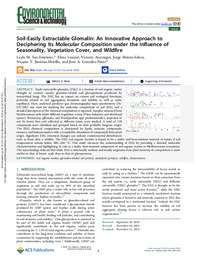Título :
Soil-Easily Extractable Glomalin: An Innovative Approach to Deciphering Its Molecular Composition under the Influence of Seasonality, Vegetation Cover, and Wildfire |
Autor :
San-Emeterioi, Layla M.
Lozano, Elena
Arcenegui, Victoria
Mataix-Solera, Jorge 
Jimenez-Morillo, Nicasio T.
González Pérez, Jose A. |
Editor :
American Chemical Society |
Departamento:
Departamentos de la UMH::Agroquímica y Medio Ambiente |
Fecha de publicación:
2024-12-09 |
URI :
https://hdl.handle.net/11000/37769 |
Resumen :
Easily extractable glomalin (EEG) is a fraction of soil organic matter
thought to contain mainly glomalin-related soil glycoproteins produced by
mycorrhizal fungi. The EEG has an impact on various soil ecological functions,
primarily related to soil aggregation formation and stability as well as water
repellence. Here, analytical pyrolysis−gas chromatography/mass spectrometry (PyGC/MS) was used for studying the molecular composition of soil EEG, and a
detailed description of the chemical composition is reported. Samples extracted from
Mediterranean soils under different vegetation covers (Pinus halepensis and shrubland
species, Rosmarinus officinalis, and Brachypodium spp, predominantly), impacted or
not by forest fires and collected at different times, were studied. A total of 139
compounds were identified and grouped based on their probable biogenic origin.
The EEG chemical composition is dominated by lipids, aromatic compounds,
steranes, and hydroaromatics with a remarkable abundance of compounds from plant
origin. Significant EEG structural changes can indicate environmental disturbances
such as those after a wildfire. The EEG soil organic fraction is found to be a stable and heat-resistant material in nature if soil
temperatures remain below 200−250 °C. This study advances the understanding of EEG by providing a detailed molecular
characterization and highlighting its role as a stable, heat-resistant component of soil organic matter in Mediterranean ecosystems.
The main findings indicate that while EEG is structurally resilient and mostly originates from plant material, its composition is more
similar to that of humic acids than to that of glycoproteins.
|
Palabras clave/Materias:
soil organic matter
glomalin-related soil protein
analytical pyrolysis
wildfire
chemometrics |
Área de conocimiento :
CDU: Ciencias puras y naturales |
Tipo de documento :
info:eu-repo/semantics/article |
Derechos de acceso:
info:eu-repo/semantics/openAccess |
DOI :
https://doi.org/10.1021/acs.est.4c10036 |
Publicado en:
Environmental Science & TechnologyVol 58/Issue 51, 2024 |
Aparece en las colecciones:
Artículos Agroquímica y Medio Ambiente
|
 La licencia se describe como: Atribución-NonComercial-NoDerivada 4.0 Internacional.
La licencia se describe como: Atribución-NonComercial-NoDerivada 4.0 Internacional.
.png)
